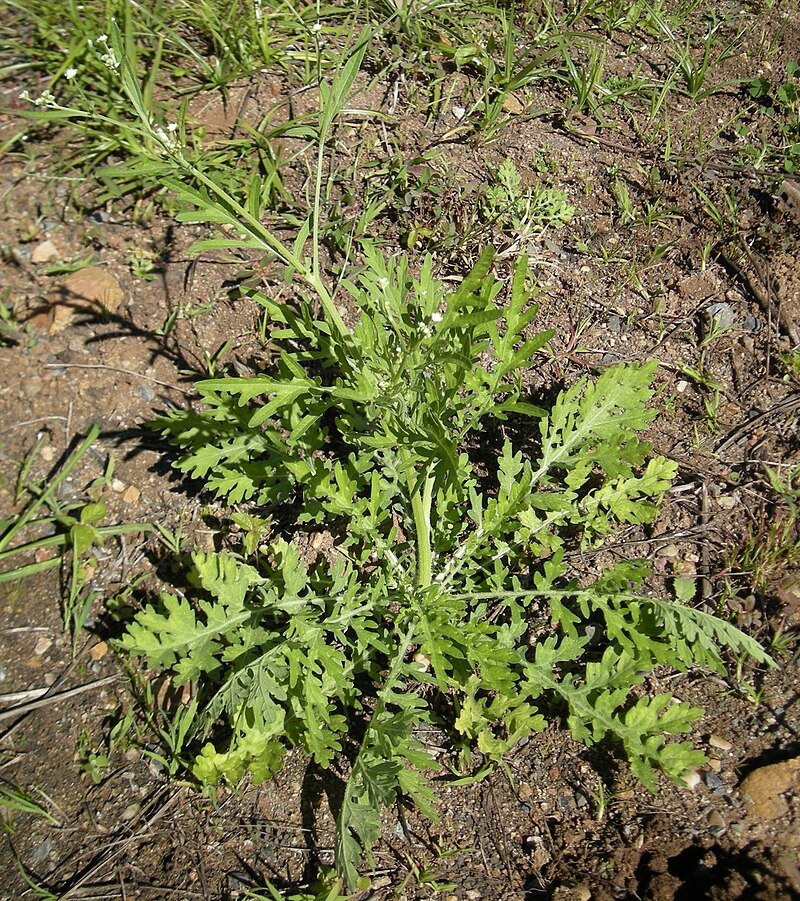Parthenium weed, scientifically known as Parthenium hysterophorus, is a notorious invasive species that has wreaked havoc on ecosystems worldwide.

Parthenium weed, scientifically known as Parthenium hysterophorus, is a notorious invasive species that has wreaked havoc on ecosystems worldwide. Its ecological impact extends beyond just outcompeting native plants.
The troublesome parthenium weed has spread across the globe, causing significant ecological, health, and agricultural problems.
However, there’s hope on the horizon in the form of biocontrol strategies. This article explores the far-reaching impact of parthenium weed and biocontrol agents—beetles and weevils—that are working to combat this invader.

 (Parthenium) Listronotus setosipennis ( Stem-boring weevil)
(Parthenium) Listronotus setosipennis ( Stem-boring weevil)
Moreover, parthenium weed’s pollen and leaf particles release allergenic compounds, causing respiratory ailments like asthma and hay fever, affecting both humans and livestock. In agricultural landscapes, it slashes crop yields, compromising food security and livelihoods.
There have been instances of parthenium weed damaging agricultural production in recent years. Food crops such as rice, wheat, and maize have seen grain yield losses of up to 40%.
According to reports, crop-weed competition during the growing season reduces the production of direct-seeded aerobic rice by 33 to 38%. According to a field study on sorghum grown in the arid conditions of Pakistan, a higher parthenium weed infestation (20 plants per square metre) led to yield losses of up to 66%.
Its presence has been observed in all countries across South Asia, and its expansion in the region is occurring at a rapid pace. The invasiveness of the parthenium can be attributed to several factors, and it exhibits adaptability to a wide range of climatic conditions with the ability to germinate and grow at a wide range of temperatures.
Additionally, the weed demonstrates tolerance to saltwater environments and possesses a deep tap root that enables it to survive in regions with low moisture levels.
The initial detection of parthenium weed in Pakistan dates back to 1980, when it was first identified in the Gujrat area of Punjab province. It is widely believed that the weed’s introduction into Pakistan resulted from its spread from India through trade and transportation channels, particularly across the Wagah border.
Management of parthenium encompasses a range of strategies, including grazing techniques, physical, chemical, and biological approaches. Physical treatments such as grading, slashing, and ploughing offer temporary relief but prove ineffective for sustained long-term management.
In grazing regions, effective parthenium control can be achieved by promoting ample growth of pasture grass to enhance competition against the weed. Traditionally, chemical control is commonly employed as the primary defence against parthenium weed. The high cost of herbicides limits their long-term application in grazing areas, public and uncultivated lands, and forests, which has prompted biological control as an alternate method.
Biological control, as a component of integrated pest management (IPM), is considered a preferred and sustainable alternative for pest control.
The stem-boring weevil Listronotus setosipennis (Hustache) (Coleoptera: Curulionidae), native to Argentina and Brazil, is considered the most important biocontrol agent of poisonous parthenium weed worldwide.
Adult females of stem L. setosipennis oviposit mostly on parthenium flowers or leaf petioles. The female adult pierces into the surface of the flower, lays an egg, and then covers it with black frass. These dented black patches (oviposition markings) represent the adult depositing eggs. After hatching, the larvae begin a hidden feeding journey, quietly chewing through the stems of their host plants.
They carefully construct intricate tunnels, slyly (secretively) concealing their presence as they carry out their destructive mission. These tunnels can be found both in the innermost pith of the stem and just below its surface, or even deep within the woody tissue near the base of the stem.
The consequences of their secretive activities are severe, as within a matter of days, the once-vibrant plant succumbs to a withering demise. The persistent feeding and tunnelling of these larvae result in a swift deterioration of the plant’s structural integrity and vital functions, leaving a troubling trail of devastation in their wake.


(Zygogramma bicolorata)


(Female adult of L. setosipennis laying eggs on parthenium flower, adult of L. setosipennis)
While biocontrol holds promise, it’s not without its challenges. Introducing beetles and weevils to control parthenium weed requires careful planning.
Scientists need to make sure these insects won’t harm other plants or become pests themselves. Climate, habitat, and other factors can also affect how well these biocontrol agents work. Constant monitoring and adjustments are necessary to ensure a healthy balance in the ecosystem.
Parthenium beetles and weevils offer a glimmer of hope in the battle against parthenium weed. These natural enemies work silently but effectively to reduce the weed’s impact. As research continues and we learn more about these biocontrol agents, we can refine our strategies and expand their use to new areas.
Parthenium weed may have disrupted ecosystems and lives, but with the power of biocontrol, we’re fighting back. By employing beetles and weevils as allies, we’re taking a step towards restoring balance to the environments that Parthenium weed has invaded.
As we forge ahead in this fight, it’s clear that a combination of science, collaboration, and a little help from nature’s tiny warriors can pave the way for a brighter, weed-free future.
This article is jointly authored by Dr. Muhammad Sufian, Dr. M. Jalal Arif, Dr. Shahid Majeed, and Yasir Iqbal from the Department of Entomology, University of Agriculture Faisalabad.